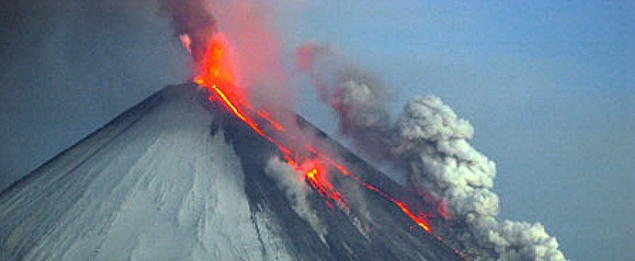New eruption began at Klyuchevskoy volcano, Russia

KVERT reported that a new eruption began at Kliuchevskoi volcano, Kamchatka, at 06:30 UTC on August 15, 2013.
Accompanied by strong tremor, strombolian activity has been taking place in the summit crater. Incandescence at the volcano's summit were observed at night and a gas-steam plume containing small amounts of ash rose up to 18,000 ft (5.5 km) a.s.l. and drifted to the north-east of the volcano on August 16.
Satellite data showed a big and bright thermal anomaly over the volcano on August 15 – 17. (KVERT weekly update)
Last update in GVP's database is from the week of March 13 – March 19, 2013: KVERT reported that activity at Kliuchevskoi decreased in late 2012, around the same time the Tolbachik eruption started. In mid-January 2013 seismic activity decreased and Strombolian activity ceased. Starting in February incandescence at the summit and thermal anomalies were not observed. Weak seismic activity continued. On 18 March the Aviation Color Code was lowered to Green, the lowest level.
Kliuchevskoi is Kamchatka's highest and most active volcano. Since its origin about 6000 years ago, the beautifully symmetrical, 4835-m-high basaltic stratovolcano has produced frequent moderate-volume explosive and effusive eruptions without major periods of inactivity. Kliuchevskoi rises above a saddle NE of sharp-peaked Kamen volcano and lies SE of the broad Ushkovsky massif. More than 100 flank eruptions have occurred at Kliuchevskoi during the past roughly 3000 years, with most lateral craters and cones occurring along radial fissures between the unconfined NE-to-SE flanks of the conical volcano between 500 m and 3600 m elevation.
The morphology of its 700-m-wide summit crater has been frequently modified by historical eruptions, which have been recorded since the late-17th century. Historical eruptions have originated primarily from the summit crater, but have also included numerous major explosive and effusive eruptions from flank craters.
Featured image: Strombolian eruptions produce incandescent plumes from the summit crater and lava flows descend the NW flanks of the volcano on May 27, 2007. Ash clouds rise from phreatic eruptions at contact of the terminus of the lava flows with snow cover. Strombolian eruptions had began on February 15, 2007 at the summit crater. Intermittent explosive activity continued, and on March 29 lava flows began traveling down the NW flank. Steam-and-ash plumes reached a maximum altitude of 10.1 km on May 27. The last ash plume was observed on July 15, after which steam plumes were seen. Photo by Yu. Demyanchuk, 2007 (KVERT).

Commenting rules and guidelines
We value the thoughts and opinions of our readers and welcome healthy discussions on our website. In order to maintain a respectful and positive community, we ask that all commenters follow these rules.